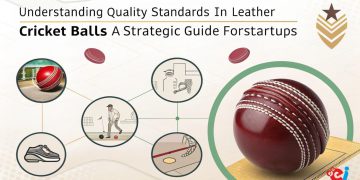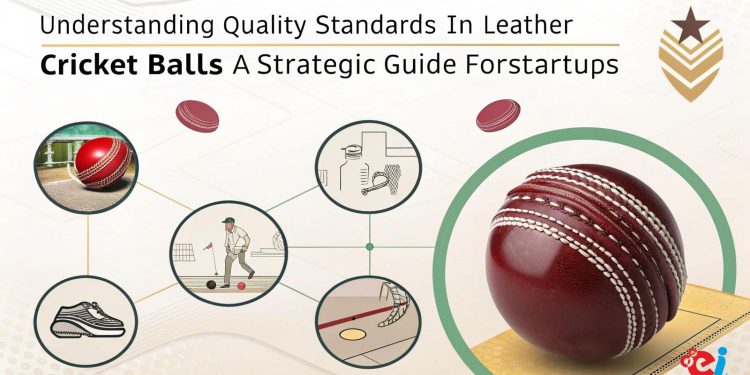India’s robust position as a leading importer and exporter showcases how important the cricket equipment sector is to the sports goods industry. Leather cricket balls, in particular, are extremely popular because they are used by amateurs and professionals alike. This makes the demand for balls high which is beneficial for businesses worldwide. Understanding the quality requirements in manufacturing and leather cricket balls is a very useful and essential step for businesses wanting to enter the industry.
Given the segmentation of the market, it does not matter if the client is a school, club, or professional team selling to them requires streamlined processes capable of fulfilling domestic and international standards if trust and growth is to be achieved. These goals can be achieved through sustainable green manufacturing processes which this guide outlines. The information provided sets out the classification strategies and compliance parameters required to gain a competitive edge in the market.
The Increasing Need for Leather Cricket Balls
India remains the leader for cricket fans, having the largest number, alongside the United Kingdom, Australia and some parts of Africa. The number of matches played like Tests, ODIs, T20s, and internally held tournaments results in there being a year-round steady demand for cricketing equipment, especially leather balls. The advantages of seam control, the ability to swing, durability and having a consistent bounce are why leather balls are required in professional matches.
For leather cricket balls, as opposed to tennis or casual play balls, it’s crucial to remark that they are a prerequisite for competitive games. The proliferation of structured leagues and training academies in cricket has drastically increased the number of matches played each year, generating an annual ‘consistent’ demand for high-quality leather balls. This is good news for newly formed companies eager to utilize skilled craftsmen and high-grade materials.
Components of a Cricket Ball Made of Leather
The requirements of modern cricket are so professional that the construction of a cricket ball made of leather must be of high standards. Each standard ball consists of 4 parts and is made from high-quality alum tanned leather of the best quality, which is stitched using linen or polyester thread. The core of the ball is constructed from closely wound cork and wool layers which are compressed and shaped in a way to maintain weight and symmetry.
The leather is polished and dyed to match the required specifications. The makeover is completed with the addition of grease or wax and the ball is stitched. It has to endure and retain shape for over 80 tales without losing grip and swing. To maximize performance and durability factors such as leather quality, stitching precision, ball balance, external bounce, and the hardness need to be regulated.
Related: How to Set up Activated Alumina (spherical Balls) Business
Grasping the Quality Criteria for Leather Cricket Balls
Traditional manufacturers must pay attention to certification guides appropriate to the Leather Cricket Balls stage of the gameplay, ranging from domestic matches to international encounters. International governing bodies like ICC and Domestic controlling boards like BCCI maintain stringent guidelines regarding the ball specifications for all the tiers of the official matches.
Weight and Dimensional Proportions:
Diameter encapsulated within the circumference should lie between 22.4 cm to 22.9 cm and mass between 155.9 to 163 grams for any men’s cricket leather balls. Women’s and junior balls are averaged closer to 140-151 grams.
Shape Retention and Balance:
Retention of perfectly spherical proportion is critical even for the prolonged and rigorous shelled activities. Retention of spherical integrity herein refers to core construction, uniform winding, coherent stitching. Trajectory is predictable and consistent with well-balanced sphere.
Seam Quality:
Crucial in seam control regarding spin or swing, remaining intact crochet without torn or unfastened threading. Remains integral, prominently featured seam tightly stitched with either 6 layers linen or polyester thread wielded using seam ensuring adequate tension.
Leather Quality and Finish:
The preferred type of leather for construction is high-grade alum tanned leather because of its toughness and almost unrefined finish. Tanning influences durability, moisture resistance, and retention of shine. Polishing with grease and shellac not only improves aesthetic value, but also adds protection to the ball while being used.
Hardness and Compression Resistance:
Use of drop tests and compression machines measures the bounce and hardness of the balls. The ball is expected to withstand deformation under repeated impacts.
Color Fastness:
For white and pink balls used in limited overs and day-night matches, the dye should be non-bleeding and adhere to the fabric claim rule, potentially under lights and damp surfaces, but not excessively.
Approval and Certification:
Cricket boards issue certification validating that the ball can be used in official matches, which is often the case for most balls. Balls that are ICC recommended face numerous trials for consistency, seam visibility, and behavior in different climates.
Those focused on providing balls for higher tier matches face stricter validations, while sponsors targeting school or club level matches base their criteria on grassroots considerations
Uses of Leather Cricket Balls and Their Types
The market for leather cricket balls can be segmented concerning their quality and intended level of use:
- International and First-Class Matches: Use them; hand-stitched and alum-tanned leather with a superior core is used for Test Match Balls, which are the highest quality.
- Test Match Balls: Has the highest quality leather cases.
- One-Day and T20 Matches: For white or pink balls designed for the shorter formats, has moderate durability and slightly different shine treatment for visibility.
- Club and Academy Balls: Practice and non-official matches use these, which are cost-effective, have decent seam and balance, and are often machine-stitched.
- School and Entry-Level Balls: Lower pricing; synthetic or mixed leather options that are mostly used for junior cricket.
Considering the quality of the match balls relative to their pricing and the marketing strategy, startups must select their target customers for the most effective customer acquisition strategy.
Related recommended book
Manufacturing and Setup Considerations
To set up a leather cricket balls manufacturing unit, one requires skilled workers, quality leather suppliers, and specialized equipment. Tasks include cutting, shaping, dyeing, and polishing the leather, preparing the cork core, winding, pressing, stitching, and finishing.
Alum-tanned leather, cork, rubber, and wool yarn make up the main raw materials, and a dye and grease are also used. Required tools are leather cutters, dye tanks, ball press machines, stitching tables, and polishing wheels.
At a capital investment of ₹25–50 lakhs with varying levels of automation, a small to medium scale unit can be self-sufficient which can produce between 500–1000 balls a day. The manual craftsmanship as well as the seam stitching and finishing still require the touch of an experienced hand, making the manual skilled labor a salient factor.
Maintaining contact with a project consultant like Niir Project Consultancy Services (NPCS) ensures that they create personalized DPRs with raw material suppliers, layout designs, area labor costs along with financial projections tailored to the size of the unit.
Branding, Packaging, and Market Entry
Another crucial yet often overlooked area in leaps of leather cricket balls business is branding. There is abundant room for newer entrants other than the Kookaburra, SG and Dukes affiliated brands in the school, club and other academies segment. Startups can construct a brand image around eco-friendliness, imperviousness and unyielding resilience or severe weather conditions.
Packaging should contain tamper-proof boxes with branding labels and product information including weight, usage category like practice, match, academy and care instructions. As a value proposition, some brands also provide custom logo printing for academies or clubs.
A popular strategy for market entry includes local dealers in sports, online stores, cricket academies, and tenders from institutions. Adoption can be facilitated by attending sports expos as well as by partnering with coaching centers and schools. New brands are advertisement-ready on e-commerce platforms which, when paired with the right digital marketing, influencer endorsements, and videos showcasing results, will become a hit target.
Financial Viability and Growth Outlook
The production cost of a good quality leather cricket balls ranges from ₹80 to ₹250, depending on the quality grade and volume. Retail prices can go from ₹150 for practice balls to ₹800–₹2,000 for high-end match balls. Bulk orders from clubs or academies allow for stable revenue streams.
With proper quality control and marketing, a startup can achieve break-even within the first 18–24 months. Long-term profitability hinges on expanding product lines (e.g., cricket kits, gloves, pads), retaining client relationships, and investing in brand recall.
With India’s cricketing ecosystem projected to grow further—thanks to grassroots programs, private leagues, and international exports—there is room for regional and niche manufacturers to scale both within India and abroad.
NPCS provides long-term support in scaling operations, exploring export markets, obtaining quality certifications, and applying for government subsidies under MSME or sports promotion schemes.
Conclusion: Delivering Performance, One Seam at a Time
Leather cricket balls are more than just a sports accessory—they are a symbol of quality, performance, and tradition in the game of cricket. For startups entering this space, success depends not just on producing a ball but on mastering the science of construction, adhering to quality standards, and building trust through consistency.
With rising domestic demand and growing export potential, this is the right time to enter the market with a brand that understands the game. By aligning with expert consultants like Niir Project Consultancy Services, entrepreneurs can take their first step into the cricketing world with confidence, precision, and strategic advantage.


























